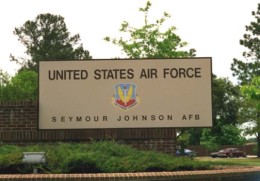| SAC Bases: Seymore-Johnson
Air Force Base |
|
|
 |
Seymour Johnson Air Force Base is
annexed to Goldsboro, North Carolina, a city on Highway 70 about midway
between Raleigh, North Carolina - the state capital - and New Bern, North
Carolina - the former capital city - on the coast.
Seymour Johnson Air Force Base occupies over 3,300
acres in the southeast section of Goldsboro. Seymour Johnson Field was
opened in April 1942 as Headquarters, Technical School, Army Air Forces
Technical Training Command. In June 1943, a secondary mission was added
which included preparation of officers and men for overseas duty. The unit
was known as the Provisional Overseas Replacement Training Center. Seymour
Johnson Field received a third mission in September 1943: to provide basic
military training for cadets preparing to become technical officers in the
Army Air Corps. The 75th Training Wing was established to conduct the
program through its Aviation Cadet Pre-Training la k- School.
The 326th Fighter Group arrived in October 1943 and in
January 1944 began training replacement pilots for P-47 Thunderbolt
aircraft. In April of that year, basic training of P-47 pilots became the
primary mission of Seymour Johnson Field. At the end of WWII in Europe,
Seymour Johnson was designated as a central assembly station for
processing and training troops being reassigned in the continental United
States and Pacific theater of operations. This function was discontinued
in September 1945 and the field became an Army-Air Force Separation
Center.
Seymour Johnson Field was deactivated in May 1946.
Community leaders were successful in their campaign to reopen the base in
1956. Seymour Johnson Air Force Base was reactivated as a Tactical Air
Command base on April 1, 1956. Three months later, the 83rd Fighter-Day
Wing was assigned to the base as the primary unit. |
|
|
|
SAC bases had sinners and
saints. Above base chapel and NCO club. |
B-52 Stratofortress
In 1958, SAC began dispersing its B-52
bombers. Prior to that each bomb wing had 3 squadrons of 15
aircraft. Each became a strategic wing and was dispersed to another
base. The 73rd Bomb Squadron of the 72nd Bomb Wing was used to
create the 4241st Strategic Wing. It was assigned to Seymore-Johnson
on Oct. 1, 1958.
The 68th Bombardment Wing moved without personnel or
equipment to North Carolina on April 15, 1963, where it replaced the
4241st Strategic Wing at Seymore-Johnson AFB. It was officially
redesignated the 68th Bombardment Wing, Heavy. It conducted strategic
bombardment training with B-52s and air refueling operations with KC-135s.
Deployed at Loring AFB, Maine from July 28 to August of 1965 and from May
27, 1972 to July 15, 1972. During this time, all wing aircraft, most
aircrew and maintenance personnel and about half of the wing's support
people were loaned to other SAC units for combat operations in Vietnam.
The 68th was inactivated Sept 30, 1982
Back to Fighters
The 4th Fighter Wing, one of the Air Forces most
distinguished fighter wings, moved to the base in 1957, replacing the 83rd
and has been the host unit since then. The 4th Fighter Wing is the
host unit at Seymour Johnson Air Force Base, and accomplishes its training
and operational missions with 92 F-15E Strike Eagles. Two of the wings
four fighter squadrons are operational units, capable of deploying
world-wide on short notice and immediately generating combat power. The
other two squadrons are responsible for training all F-15E aircrews for
the Air Force. |
|
